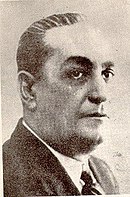Luis Lloréns Torres
Luis Lloréns Torres | |
|---|---|
 Luis Lloréns Torres | |
| Born | May 14, 1876 Collores, Juana Díaz, Puerto Rico |
| Died | June 16, 1944 (aged 68) Santurce, Puerto Rico |
| Pen name | Luis de Puertorrico[1] |
| Occupation | poet, playwright, politician |
| Nationality | Puerto Rican |
| Alma mater | University of Granada |
Luis Lloréns Torres(May 14, 1876 – June 16, 1944), was aPuerto Ricanpoet,playwright,andpolitician.He was an advocate for theindependence of Puerto Rico.
Early years[edit]
Llorens Torres was born inJuana Diaz, Puerto Rico.His parents, Luis Aurelio del Carmen Llorens and Marcelina Soledad de Torres, were the wealthy owners of a coffee plantation. InCollores(abarrioof Juana Diaz), Llorens Torres was always in contact with nature, which accounts for the love that he felt for nature and country. He always stated that he was proud to come from Collores barrio.[2]His poemEl Valle de Colloresmade the barrio one of the most well-known of the island of Puerto Rico.[3] HisCatalangrandfather, Josep de Llorens i Robles, immigrated fromFigueres,province of Girona,Spain.[4]
Llorens Torres went to school inMayagüezandMaricao.He went toSpainafter he finished his secondary studies on the island and studied at theUniversity of Barcelonawhere he began his studies. He then proceeded to study Philosophy and Letters at theUniversity of Granadawhere he obtained both a Doctorate degree and a law degree. In Spain he published his first book of poetic verses "Al Pie de la Alhambra", which was dedicated to the woman who would eventually become his wife, Carmen Rivero.[5]
Political career[edit]
Llorens Torres returned to Puerto Rico in 1901, married, and moved toPoncewhere he established his own law firm (Nemesio Canaleslater joined his firm) and collaborated with the newspaperLienzos del Solar.During this time he wrote some of his best works.[5]He also met numerous poets like Julia de Burgos.
When Llorens Torres returned to Puerto Rico he found a political situation completely different than from the one that he had left. Puerto Rico had been invaded by theUnited Statesduring thePuerto Rico Campaignof theSpanish–American Warin 1898. This motivated Llorens Torres to join the politicalUnion Party of Puerto Rico.The ideal of independence for the island. He transmitted his beliefs to the public through his poem "El Patito Feo" (The Ugly Duckling). He became a member of the Puerto Rican legislature and was named to the Camara of Delegates from 1908 to 1910 representing the municipality of Ponce. On February 8, 1912, together withRosendo Matienzo CintrónandManuel Zeno Gandía,he wrote a manifesto which stated that it was time for Puerto Rico to have its independence. That year Llorens Torres, Rosendo Matienzo Cintrón, Manuel Zeno Gandía,Eugenio Benítez Castaño,andPedro Franceschifounded the Independence party which was the first party in the history of the island to exclusively wantPuerto Rican independence.Eugenio Benítez Castaño was named president of the short lived political party. In 1913, Llorens Torres co-founded with Nemesio CanalesLa Revista de Las Antillas...,a literary publication.[1]
Grito de Lares[edit]
Llorens Torres' historical drama,ElGrito de Lares(The Cry of Lares),deals with the attempted overthrow of theSpanish government on the islandwith the intention of establishing the island as asovereignrepublic.In the book, he describes theflag of the revoltcreated byMariana Bracetti.The flag was divided in the middle by a white cross, the two lower corners were red and the two upper corners were blue. A white star was placed in the upper left blue corner.[6]According to Llorens Torres, the white cross on theGrito de Laresflagstands for the yearning for homeland redemption, the red squares, the blood poured by the heroes of the rebellion, and the white star in the blue solitude square, stands for liberty and freedom.[7][8]
Works[edit]
Among his works are décimas and poems:[1][9][10]
- Al pie de la Alambra,1899 poem[11]
- La Revista de las Antillas,newspaper founded in 1913
- Juan Bobo,magazine
- Idearium,magazine
- Valle de Collores,(Collores) 1940décima/ poem
- Canción de las Antillas,(Song of the Antilles) 1913 poem
- Sonetos Sinfónicos,1914 book
- Distant Song, 1926 poem
- Rapsodia Criolla,(Creole Life), 1935 poem
Death[edit]
Llorens Torres died inSanturce,abarrioof San Juan, Puerto Rico. He defended the ideal of Puerto Rican independence until the day he died and was buried at the Puerto Rico Memorial Cemetery inCarolina, Puerto Rico.[1]
Legacy[edit]
The Government of Puerto Rico has honored the memory of Luis Llorens Torres by naming a public housing project (Residencial Luis Lloréns Torres) in Santurce after him. Among the other things that were named after him are an avenue in San Juan, a high school in Juana Diaz, and a children's academy inNew York City.There is a bust of him in front of the high school named after him and there is a statue of Luis Llorens Torres, sculpted by the Puerto Rican sculptorTomás Batista,in the "Plazita Famosa" of Juana Diaz.[1]
See also[edit]
References[edit]
- ^abcdeEl Nuevo DiaArchived2011-09-27 at theWayback Machine
- ^"Luis Lloréns Torres".EnciclopediaPR(in Spanish). 2020-10-11.Retrieved2021-07-04.
- ^Inocencio, Rafael Torrech San (January 2019)."Historia del Barrio de Collores 80 Grados R.Torrech Julio 2019".80 Grados– via academia.edu.
- ^Marrero, C. (1968). Luis Llorens Torres, vida y obra.
- ^ab"Biografía de Luis Llorens Torres".los-poetas.
- ^The Women from Puerto Rico.Mariana BracettiArchived2008-07-08 at theWayback Machine
- ^"Lares--municipio de Puerto Rico-datos y fotos-videos".prfrogui.
- ^Lloréns Torres, Luis.El Grito de Lares(in Spanish).Retrieved2021-07-03– via Issuu.
- ^Pierret, A.P.; Pérez, A.C. (1998).Antonio Pérez Pierret: Obra Poética(in French). Editorial de la Universidad de Puerto Rico. p. 19.ISBN978-0-8477-0318-0.RetrievedAugust 2,2019.
- ^Márquez, Robert (2007).Puerto Rican Poetry: A Selection from Aboriginal to Contemporary Times.University of Massachusetts Press. p. 148.ISBN978-1-55849-562-3.RetrievedAugust 2,2019.
- ^Rivera, Limarí."Luis Llorens Torres, poeta al pie de las ruinas".Revista de Estudios Hispánicos, Año I, No. 2, 2014(in Spanish). pp. 177–186.Retrieved2021-07-03.
External links[edit]
- 1876 births
- 1944 deaths
- University of Barcelona alumni
- University of Granada alumni
- Puerto Rican journalists
- Puerto Rican dramatists and playwrights
- Puerto Rican poets
- Puerto Rican male writers
- Puerto Rican nationalists
- Puerto Rican people of Catalan descent
- Politicians from Ponce
- People from Juana Díaz, Puerto Rico
- Puerto Rican independence activists
- American male non-fiction writers
